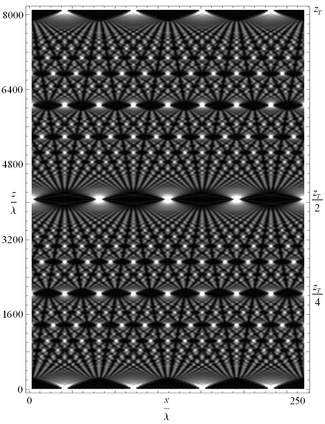
Talbot effect
Encyclopedia

Diffraction grating
In optics, a diffraction grating is an optical component with a periodic structure, which splits and diffracts light into several beams travelling in different directions. The directions of these beams depend on the spacing of the grating and the wavelength of the light so that the grating acts as...
,
its image is repeated at regular distances away from the grating plane. The regular distance is called the Talbot length, and the repeated images are called self images or Talbot images. Furthermore, at half the Talbot length, a self image also occurs, but phase-shifted by half a period (the physical meaning of this is that it is laterally shifted by half the width of the grating period). At smaller regular fractions of the Talbot length, sub-images can also be observed. At one quarter of the Talbot length, the self image is halved in size, and appears with half the period of the grating (thus twice as many images are seen). At one eighth of the Talbot length, the period and size of the images is halved again, and so forth creating a fractal pattern of sub images with ever decreasing size, often referend as Talbot carpet.
Lord Rayleigh showed that the Talbot effect was a natural consequence of Fresnel diffraction
Fresnel diffraction
In optics, the Fresnel diffraction equation for near-field diffraction, is an approximation of Kirchhoff-Fresnel diffraction that can be applied to the propagation of waves in the near field....
and that the Talbot length can be found by the following formula:

where
 is the period of the diffraction grating and
is the period of the diffraction grating and  is the wavelength
is the wavelengthWavelength
In physics, the wavelength of a sinusoidal wave is the spatial period of the wave—the distance over which the wave's shape repeats.It is usually determined by considering the distance between consecutive corresponding points of the same phase, such as crests, troughs, or zero crossings, and is a...
of the light incident on the grating.
The atomic Talbot effect
Due to the quantum mechanical wave nature of particlesElementary particle
In particle physics, an elementary particle or fundamental particle is a particle not known to have substructure; that is, it is not known to be made up of smaller particles. If an elementary particle truly has no substructure, then it is one of the basic building blocks of the universe from which...
, diffraction effects have also
been observed with atoms - effects which are similar to those in the case of light.
Chapman et al. carried out an experiment in which a collimated beam of sodium
Sodium
Sodium is a chemical element with the symbol Na and atomic number 11. It is a soft, silvery-white, highly reactive metal and is a member of the alkali metals; its only stable isotope is 23Na. It is an abundant element that exists in numerous minerals, most commonly as sodium chloride...
atoms was passed through two diffraction gratings (the second used as a mask) to observe the Talbot effect and measure the Talbot length. The beam had a mean velocity of corresponding to a de Broglie wavelength of
 = . Their experiment was performed with 200 and gratings which yielded Talbot lengths of 4.7 and respectively. This showed that for an atomic beam of constant velocity, by using
= . Their experiment was performed with 200 and gratings which yielded Talbot lengths of 4.7 and respectively. This showed that for an atomic beam of constant velocity, by using  , the atomic Talbot length can be found in the same manner.
, the atomic Talbot length can be found in the same manner.
